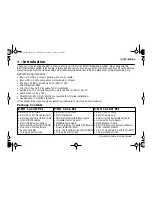
2-26
Functional Description
KPCI-3110 and KPCI-3116 User’s Manual
The duty cycle (or pulse width) indicates the percentage of the total pulse output period that is
active. A duty cycle of 50, then, indicates that half of the total pulse is low and half of the total
pulse output is high. You specify the duty cycle in software.
Figure 2-10
illustrates a low-to-high pulse with a duty cycle of approximately 30%.
Figure 2-10
Example of a low-to-high pulse output type
Counter/timer operation modes
KPCI-3110 and KPCI-3116 boards support the following counter/timer operation modes:
•
Event counting
•
Frequency measurement
•
Rate generation
•
One-shot
•
Repetitive one-shot
The following subsections describe these modes in more detail.
Event counting
Use event counting mode to count events from the counter’s associated clock input source.
If you are using one counter, you can count a maximum of 65,536 events before the counter rolls
over to 0 and starts counting again. If you are using a cascaded 32-bit counter, you can count a
maximum of 4,294,967,296 events before the counter rolls over to 0 and starts counting again.
In event counting mode, use an external C/T clock source; refer to
page 2-23
for more informa-
tion on the external C/T clock source.
Using DriverLINX software, specify the counter/timer mode as event counting (count), the C/T
clock source as external, and the gate type that enables the operation. Refer to
page 2-25
for
information on gates.
Ensure that the signals are wired appropriately.
Figure 2-11
shows one example of connecting an
event counting application to the STP-3110 screw terminal panel using user counter 0. In this
example, rising clock edges are counted while the gate is active.
Total Pulse Period
Active Pulse Width
Low Pulse
High Pulse
Содержание KPCI-3110
Страница 3: ......
Страница 4: ......
Страница 7: ......
Страница 8: ......
Страница 16: ...Preface...
Страница 20: ...1 Overview...
Страница 25: ...2 Functional Description...
Страница 54: ......
Страница 55: ......
Страница 57: ......
Страница 58: ......
Страница 59: ......
Страница 61: ...3 Installation and Configuration...
Страница 66: ......
Страница 68: ......
Страница 80: ......
Страница 81: ......
Страница 82: ......
Страница 83: ......
Страница 84: ......
Страница 85: ......
Страница 86: ...4 Testing the Board...
Страница 89: ...5 Calibration...
Страница 92: ...6 Troubleshooting...
Страница 99: ...A Specifications...
Страница 111: ...B Connector Pin Assignments...
Страница 116: ...C Systematic Problem Isolation...
Страница 143: ...D Using Your Own Screw Terminal Panel...
Страница 156: ......
















































